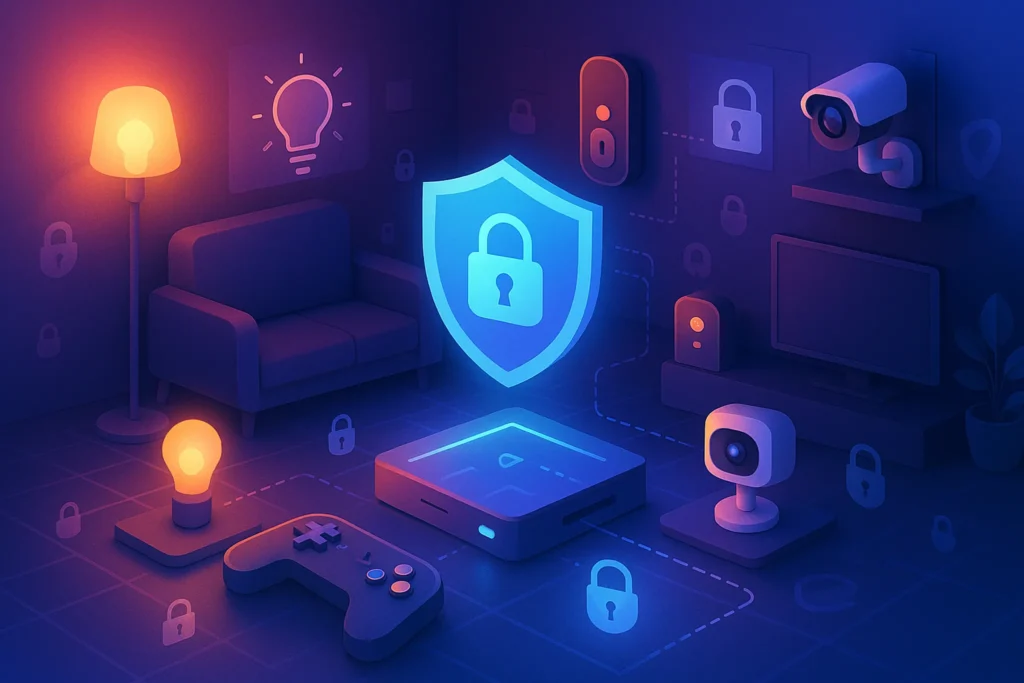-This post may contain affiliate links. If you click on one and make a purchase, I may earn a small commission at no extra cost to you.-
🧠 Introduction
As smart home devices become more prevalent in 2025—from voice assistants to Wi‑Fi cameras—they also bring fresh security risks. Threats include network vulnerabilities, firmware flaws, and voice-eavesdropping hacks. This guide walks you through 10 actionable steps to secure your smart home, reduce data leaks, and enjoy full peace of mind.
🔐 Step 1: Change Default Router Credentials & Use Strong Encryption
💡 Why It Matters:
Hackers routinely scan for routers with unchanged admin credentials or old firmware. Once inside, they can intercept unencrypted traffic and potentially control connected devices.
🛠️ How-To Detail:
-
Change your router’s IP login (e.g. 192.168.1.1), then update both SSID and admin password
-
Set SSID to something neutral (avoid names like “HomeCamera_Network”)
-
If WPA3 isn’t supported, ensure you’re on WPA2-AES (not TKIP, which is deprecated)
-
For advanced users: disable ICMP ping and change DHCP range to obscure access points
Most routers ship with weak default passwords and outdated settings.
-
Set a unique admin password (12+ characters, mix of letters, numbers, symbols)
-
Use WPA3 encryption if available, or WPA2 AES as a fallback
-
Disable WPS, UPnP, and remote management unless you need them
-
Segment your network with guest or IoT SSIDs to isolate smart devices from PCs/phones
Small router changes can block 80–90% of common IoT hacks.
🔐 Step 2: Create an Isolated IoT Network
🔒 Why It Works:
Most smart home exploits start from lateral movement—once inside your network, one weak device gives access to everything. A separate network blocks this.
📶 Setup Tip:
-
On most routers: log in, go to Wireless Settings → create Guest SSID → disable “allow guest to access LAN”
-
For best results, combine this with a dedicated VLAN (on routers like UniFi, ASUS Pro, or TP-Link Omada)
-
Use network names like “SmartThings_IoT” to identify purpose while keeping personal info private
📲 Bonus: Apps like Home Assistant let you group and control all IoT traffic from a local interface, making it easier to isolate without losing functionality.
Keeping smart devices off your main network is essential.
-
Enable a guest Wi‑Fi network for all IoT
-
Keep your primary devices (laptops, phones) on the main network
-
Many mesh or router setups let you easily segment traffic
This prevents a compromised device (like a robot vacuum) from giving hackers access to your PC.
🔏 Step 3: Use Unique, Strong Passwords + 2FA
🚫 Why Reuse Kills Security:
Credential-stuffing attacks use old leaks to breach multiple services. If your smart plug password is the same as your email—it’s game over.
🔐 Pro Tips:
-
Use Bitwarden, 1Password, or KeePassXC to generate and manage device-specific logins
-
Set up recovery methods (backup codes or authenticator apps) for every account
-
For shared household access, never share raw passwords—use secure invites or sub-users
👀 Watch Out: Many IoT platforms don’t log failed login attempts. If 2FA isn’t available, change your passwords monthly.
Avoid common passwords and reuse.
-
Generate unique passwords with a password manager
-
Activate Two-Factor Authentication (2FA) for device accounts and cloud apps
-
For devices without 2FA, enable screen locks or pin codes
This stops attackers even if one password is exposed.
🧩 Step 4: Keep Firmware Updated Automatically
🕳️ Why It’s Crucial:
Most IoT hacks come from known CVEs (Common Vulnerabilities and Exposures) that go unpatched because users forget to update firmware.
📈 Maintenance Routine:
-
Schedule the 1st weekend of each month as Smart Device Check Day
-
Open each brand’s app (TP-Link, Philips Hue, Ring, etc.) → Check for firmware updates
-
For unsupported devices: search brand + “firmware update file” manually and apply via USB or companion software
🧠 Insight: Some older devices won’t notify you about critical patches unless you actively open the app.
Out-of-date firmware is a top entry point.
-
Enable auto-updates where available
-
Check weekly for security patches from maker apps or logins
-
Replace devices no longer supported (no updates in 2+ years)
Regular updates can eliminate vulnerabilities in smart locks, bulbs, and cameras.
🛡️ Step 5: Disable Unnecessary Features & Cloud Access
🗣️ Reduce Exposure:
Voice assistant shopping, always-on microphones, and 24/7 cloud sync increase your risk profile dramatically—especially if unused.
🧩 Suggested Deactivations:
-
Disable voice purchase on Alexa or Google Assistant via app settings
-
Turn off “usage reporting” or “diagnostics sharing” under device privacy menus
-
On smart TVs: disable automatic content recognition (ACR), which tracks what you watch
-
Use “manual control only” where devices offer both cloud and local modes (like Yeelight, Shelly, or Homebridge-supported gear)
Extra features often increase risk.
-
Turn off camera/mic access unless use is active
-
Avoid enabling cloud features if local control is enough
-
Disable voice-activated purchasing mechanisms
-
Decline analytics tracking or telemetry settings
For smart speakers, closing “always-listening” features can prevent eavesdropping.
🗣️ Step 6: Protect Against Voice Assistant Eavesdropping
🎙️ Why You Should Care:
Voice assistants can misinterpret ambient sounds or media and activate unintentionally, recording snippets that get uploaded to the cloud. In rare cases, this has led to accidental sharing of private conversations.
🧠 Smart Configurations:
-
Check the Alexa or Google Home app activity log weekly and delete voice history
-
Adjust voice assistant settings to require confirmation before executing sensitive commands (e.g., purchasing or unlocking)
-
Change default wake words to less-used triggers to reduce accidental activation (e.g., “Echo” instead of “Alexa”)
🎧 Physical Security Bonus: Place assistants away from windows or entryways—attackers have used ultrasonic replay from outside homes to trigger commands.
Voice assistants pose distinct privacy risks:
-
Mute or disable mic when not in use
-
Change wake-word if possible (Alexa, Hey Google)
-
Regularly review and delete voice logs in the app
-
Use voice recognition features when available
“Audio injection” attacks replay triggers via speakers to hijack devices. Disabling mic access when idle is critical.
📡 Step 7: Secure Communication with Encryption & VPN
🔐 Why It Helps:
Even if your devices are password-protected, unencrypted traffic can be intercepted and read by attackers, especially on public Wi‑Fi or during remote control.
📦 Advanced Security Tips:
-
Use routers that support OpenVPN or WireGuard natively to route smart home traffic securely
-
Only install IoT devices that explicitly mention HTTPS/TLS support in their specs
-
Avoid using public IP exposure unless behind a VPN or reverse proxy with encryption (like NGINX + Certbot SSL)
💡 Bonus: For highly sensitive smart systems (like door locks), prefer local-first ecosystems like Apple HomeKit or Home Assistant with Z-Wave/Zigbee.
Protect data traveling between your home and devices:
-
Choose devices using TLS encryption (indicated in specs)
-
Use a VPN on your router for remote control
-
Prefer local-control hubs (HomeKit, Matter, Zigbee) over external cloud
Encrypting voice and camera streams prevents interception.
🧠 Step 8: Monitor Device Activity & Network Behavior
🧪 Real-World Scenarios to Watch For:
-
A smart plug turning on/off randomly
-
Unusual spikes in bandwidth usage
-
Devices appearing in router logs outside your usage hours
📊 Monitoring Tools:
-
Fing (mobile): Instantly shows unknown devices on your Wi‑Fi
-
GlassWire (desktop): Tracks per-app internet activity
-
Pi-hole: Blocks tracking domains and logs DNS activity—ideal for smart TVs and assistants
🔁 Routine:
Every two weeks, log into your router and export device logs. Watch for MAC addresses you don’t recognize or activity outside sleeping hours.
Early warning signs are key.
-
Check router logs for unknown devices
-
Use network monitors like Fing or GlassWire
-
Inspect devices regularly for unexpected reboot, strange behavior, or sluggishness
Proactive monitoring can detect compromised smart vacuums or cameras early.
🔑 Step 9: Enable Local Control & Minimal Cloud Dependency
📶 Why Local Control Wins:
Cloud-based control means you’re dependent on third parties and internet uptime. A local-first setup gives faster responses and removes cloud risks.
🏡 Tools That Prioritize Local Control:
-
Home Assistant: Free, open-source smart home hub
-
Hubitat: Paid local automation hub with minimal cloud exposure
-
Matter Protocol: New 2025 standard backed by Google, Apple, Amazon—supports secure local control by default
📴 Pro Move: Once local automation is stable, disable internet access for specific devices at the router level (especially cameras and smart plugs).
Local system control enhances resilience.
-
Choose platforms that work offline: Matter, Zigbee, Z‑Wave, HomeKit
-
Turn off cloud backup if you don’t need remote access
-
Consider investing in local smart hubs rather than hubless cloud devices
This strategy ensures core smart functions work even if the internet is down.
🧰 Step 10: Educate Everyone and Set a Security Routine
👥 Why This Step is Often Missed:
Even with the best tech setup, one uninformed user can open the door to an exploit—like reusing passwords or enabling mic access without realizing.
🏠 Family-Wide Routine Suggestions:
-
Print a “Smart Home Security Checklist” and stick it on the fridge
-
Schedule a monthly device audit where each family member checks one product
-
Create a shared note (e.g., in Google Keep or Notion) for all passwords, recovery options, and brand support links (with access control!)
🧠 Ongoing Education:
Follow blogs like Krebs on Security, Reddit’s r/IOTSecurity, or manufacturer newsletters for alerts on device vulnerabilities.
Security works best when the household is onboard.
-
Teach family how to reset secure Wi‑Fi or revoke access
-
Set up monthly security checks: updates, password changes, log review
-
Stay updated on new threats—subscribe to reputable sources
Hackers often exploit the most careless target—the uninformed user.
🧠 Nerd Verdict
Securing your smart home doesn’t require elaborate tech—just clear steps, regular maintenance, and mindful device use. By following this roadmap, you’ll protect your privacy, reduce risk, and still enjoy the convenience of smart living in 2025.
Before diving too deep into smart home security, it’s important to start with a solid setup. If you’re still configuring your ecosystem or looking for the best devices to integrate, check out The Ultimate Smart Home Setup Guide: Gadgets, Tips, and Tricks — it covers the essential tools and layout tips that pair perfectly with the security practices discussed here.
❓ FAQ
Q: My devices are local—do I still need a VPN?
A: Even for local control, VPN protects when you’re away from home. It also prevents ISP-level monitoring of device usage.
Q: Is WPA3 worth installing on my router?
A: Absolutely. WPA3 offers stronger encryption and better protection than WPA2, especially for IoT traffic. Use WPA2 only if WPA3 is unavailable.
Q: Are all firmware updates automatic?
A: No. Some low-cost devices require manual updates via apps. Check monthly and consider replacing devices that’re no longer updated.
Q: Should I avoid smart bulbs and plugs entirely?
A: Not necessarily. Choose reputable brands that support local control and segmentation. Avoid using smart plugs for sensitive appliances like door locks.
 Would You Bite?
Would You Bite?
Which of these smart home security upgrades are you applying first?
Tell us in the comments and help others avoid rookie mistakes—we’re reading every tip you share. 👇



